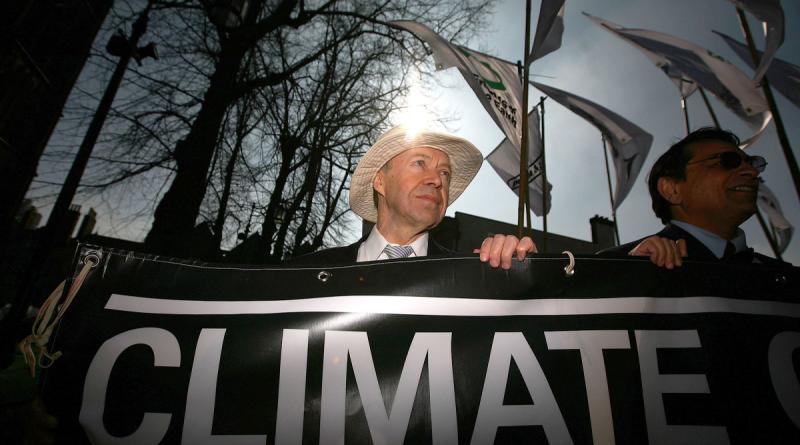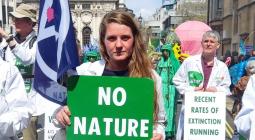Scientists warned about climate change in 1965. Nothing was done.

I’m Adam Levy, and this is Knowable.
This season we’re focusing our investigations on just how and when ideas in science develop. In each episode, we’re investigating one text that’s changed the way we think, except in this episode we are looking at a groundbreaking climate text that changed very little in our actions to halt climate change. The fundamentals of the science around the greenhouse effect date back to Joseph Fourier some 200 years ago. But when I think of climate change warnings, I often think back to Al Gore’s film, An Inconvenient Truth, from 2006.
Al Gore: And that is what is at stake: Our ability to live on planet Earth.
Adam Levy: Or, perhaps, NASA scientist Jim Hansen’s 1988 US Senate warning.
Jim Hansen: This evidence represents a very strong case, in my opinion, that the greenhouse effect has been detected and it is changing our climate now.
Adam Levy: The truth is that there’s no single moment when the threat of human-caused climate change broke out of academia and arrived in public consciousness.
In this episode, I want to look back on one particular moment in the history of climate science with profound political importance: The first time a president of the United States of America was explicitly warned about the dangers of burning fossil fuels.
This came long before Al Gore or even Jim Hansen’s climate warnings, way back in 1965. So over half a century later, let’s find out just how well the science of this report has held up, and why we are still struggling so many decades later to get our act together to halt global warming.
The US president at the time was Lyndon B. Johnson, also known as LBJ. The report came from LBJ’s Science Advisory Committee and was titled Restoring the Quality of Our Environment. As well as detailing the very direct ways that human society was polluting air, water and land, the report contained an entire section discussing carbon dioxide from fossil fuels, which it poetically described as “the invisible pollutant.”
The report noted that “through his worldwide industrial civilization, man is unwittingly conducting a vast geophysical experiment,” and that this will modify the heat balance of that atmosphere to such an extent that marked changes in climate not controllable through local or even national efforts could occur.
Dana Nuccitelli: I was surprised at how accurately they predicted the different things that would happen.
Adam Levy: This is environmental scientist Dana Nuccitelli, who’s research coordinator for Citizens’ Climate Lobby, which aims to build political will for climate solutions through citizen volunteers. When Dana came across the report, he found it stood up remarkably well.
Dana Nuccitelli: They predicted Antarctic ice would be melting, sea levels would be rising, water would be acidifying, temperatures in both the air and oceans would be rising. So they got a lot of specific climate change impacts right.
Adam Levy: Much of Dana’s career has been dedicated to combating misinformation around climate change, and several longstanding myths are actually tackled head-on in this decades-old report. For example, the report makes clear that carbon dioxide can have planet-sized effects despite being invisible and being present in our atmosphere only in small concentrations.
Dana Nuccitelli: In the past, that was a great source of frustration. A big thing that I did in my writing was debunking these same climate myths, and they would just keep popping up and popping up, and you would think, ‘Oh, well, scientists were addressing these many, many decades ago,’ and yet these myths just never seem to die, and they just kept popping up and popping up.
Adam Levy: The need to act on this was already apparent to the authors of the report, who suggested a radical solution. As they put it, “The possibilities of deliberately bringing about countervailing climatic changes therefore need to be thoroughly explored” — in other words, finding some way to modify the climate that could undo the warming caused by carbon dioxide. This idea, now called geoengineering, has not stood the test of time so well. While it’s still considered by researchers, it’s treated far more cautiously than it was half a century ago.
Dana Nuccitelli: It is certainly a risky thing to do because we don’t know exactly what the unforeseen consequences of that might be. I think pretty much the entire scientific community views it as a ‘break glass in case of emergency,’ last-ditch measure.
Adam Levy: Almost exactly 50 years after this 1965 report, the world finally came together to reach the Paris Climate Agreement aiming to limit how much our actions heat the planet. For Dana, looking back at this report handed to a US president so many years before meaningful progress was made is a somewhat frustrating experience.
Dana Nuccitelli: It makes me wish that we had listened to scientists much sooner. I started getting into communicating climate science in 2010, and that subsequent decade or so was very, very frustrating in having to constantly debunk myths and seeing that nobody was really listening to the scientists. And then, you look back at these reports from the 1960s and ’70s and ’80s, and it’s just frustration that they weren’t listened to earlier.
Adam Levy: So why weren’t climate scientists listened to earlier? Why did this warning direct to the president of the United States not lead to any significant efforts to change course for decades thereafter? Did the report just immediately disappear into a political void? Historian of science Naomi Oreskes of Harvard University has focused much of her career on investigating what scientists understood about climate change and when. She began this work in the early 2000s.
Naomi Oreskes: Most people at that time were not really aware that there was a deep history of climate science that went back into the 1970s and even earlier, and so I started to learn more about it, and that led me to this 1965 report. And that report was one of the first important places where scientists made the attempt to alert the US government on the highest possible levels to the reality of climate change and the threat that this would become a very, very serious problem in the years to come.
Adam Levy: Now, do you remember your feeling when first coming across this report that a president was warned way back in 1965?
Naomi Oreskes: I was doing this work in the 2000s. Most people were talking about climate change as something that had only recently come to scientific and political attention, but I certainly do remember when I came across this report thinking, wow, it’s not just that they were doing the science, but it’s that they recognized that it had really serious social, political and economic consequences, and that it was important for them not to just let this be buried in the scientific literature, but to try to communicate to political leaders the significance of this problem.
Adam Levy: Are there any particular passages or themes in this warning about the so-called invisible pollutant that jump out at you now or jumped out at you at the time?
Naomi Oreskes: Sometimes the whole question of climate change is misrepresented by people who will say, ‘Oh, well, we know climate change is happening, but we don’t really know what the cause is. Or it’s only recently that we figured out the cause.’ That is a complete misrepresentation of the scientific framing. These scientists were concerned about climate change because they were specifically concerned about how burning fossil fuels put carbon dioxide and other greenhouse gases into the atmosphere. They had done calculations of how much fossil fuel was being used at that time, and therefore how much greenhouse gas was being added to the atmosphere, so it’s quite specific quantitatively. It’s not just a vague or general claim. It’s a specific quantitative scientific claim. And of course, it’s a claim that in hindsight we can say it turned out to be correct.
Adam Levy: So was there actually any response from President Lyndon B. Johnson at the time? Any acknowledgement of what this report was warning of?
Naomi Oreskes: Johnson followed up this report with a special message to Congress on [conservation and restoration of natural] beauty. And in that special message, he specifically speaks about carbon dioxide and changes in the atmosphere of the planet that could have significant environmental effects. So we know that the president, or at least his speech writers were aware of this report and used it to raise the issue of carbon dioxide and the greenhouse gases and the greenhouse effect in a message to Congress that year. And he says, this generation has altered the composition of the atmosphere on a global scale through a steady increase in carbon dioxide from the burning of fossil fuels — and that was in 1965.
Adam Levy: Naomi was so struck by this early acknowledgement of the harms of fossil fuels that she included this LBJ quote in the introduction to her book, Merchants of Doubt. Her book discusses the misinformation campaigns that have been waged over climate science. And so, when I spoke to Naomi, we discussed why the report led to so many years of inaction on climate change.
Naomi Oreskes: I’d say there was action initially, but then that further action was blocked. We know that there was extensive discussion of the problem in the context of the passage of the Clean Air Act in 1970, which is one of the fundamental pieces of environmental legislation that was put into place in the late ’60s and early ’70s. Now, what happened is that throughout the 1970s, the science is still somewhat speculative in the sense that the scientists don’t have a very specific and clear idea exactly how these adverse impacts will play out.
But by the 1980s, that begins to change. With the rise of climate modeling, the science becomes more specific, more quantitative. And in 1988, the IPCC, the Intergovernmental Panel on Climate Change, is created specifically to summarize and assess the scientific evidence on this problem, in order to report to governments, who would then act upon it.
And what we know from our research is that as the IPCC begins to gather, and as the scientific consensus and the problem begins to coalesce, that’s when the fossil fuel industry changes course. And that’s when they make what I consider to be a fatal and, in my opinion, tragic choice: Rather than accepting the science and beginning to think how they could change their business model to address the problem, they go down the path of disinformation and obstruction.
Adam Levy: And can you spell out a little more what that disinformation and obstruction campaign has looked like, especially in the United States?
Naomi Oreskes: The fossil fuel industry did two things. First, at ExxonMobil, they dissolved their climate research group. They either fired the scientists or had them move on to other things. And instead, they began to work with other fossil fuel companies to create organizations that would spread doubt about the reality of climate change, doubt about the integrity of the science and doubt about the motivation of scientists. So just to give you one example, ExxonMobil played a leading role in creating a group called the Global Climate Coalition to prevent the United States from signing the Kyoto Protocol to the UN Framework Convention on Climate Change, in order to prevent meaningful policy action.
And the way they did this — and this is spelled out in chapter and verse in their own documents — was to cast doubt on the science: to say that we didn’t really know for sure and therefore it would be premature to act. And we know that the Global Climate Coalition were successful in stopping the United States from ratifying the Kyoto Protocol. And in fact, after the defeat of Kyoto in the United States, the Global Climate Coalition disbanded because, in their own words, they had achieved their goal.
Adam Levy: Now, I think we often take fairly for granted that climate change is a partisan issue in the United States, with the Republican Party, specifically, routinely denying scientific evidence and opposing climate action. How did it actually get to this state, and has it always been treated as a partisan issue in the United States?
Naomi Oreskes: No. It hasn’t always been partisan. It was made partisan, and making it partisan was part of the strategy of obstruction. They also accused climate scientists and their supporters of having a left-wing agenda. They accused scientists of being socialists who were trying to bring in government control of the marketplace. And so they deliberately framed this as a political issue that juxtaposed progressives who believe in the positive role of government to serve the common good versus conservatives who are trying to protect and defend individual liberty against what they would argue was an encroaching, you know, the heavy hand of big government.
Adam Levy: Can you share any prominent examples of Republicans who were vocally supportive of climate action, perhaps, before this active aim to sow division?
Naomi Oreskes: So when George H.W. Bush ran for president, he had a reputation as being a moderate to moderately conservative Republican. But when he ran for office, he said that he was going to address the problem of climate change, and he specifically said he was going to bring the power of the ‘White House effect’ to fight the greenhouse effect.
And when he became president, he went to Rio de Janeiro in 1992, to the Earth Summit where the UN Framework Convention on Climate Change was presented, and he signed it. And when he signed it, he declared that he was determined to turn the written words on the document into concrete action to protect the planet. But that didn’t happen because it’s right around that time, around the time of the Rio meeting, that the forces of obstruction really take hold and get serious. And so we see a turnabout in policy in the Bush administration itself, and by the mid- to late 1990s, you’re really hard-pressed to find a Republican leader in America, with the notable exception of Senator John McCain, who is prepared to offer leadership on this issue.
Adam Levy: Given so many decades of inaction and division around climate change, how do you feel when you look back at what was actually known, which particular times, and the fact that there was this warning to a president some 57 years ago?
Naomi Oreskes: I feel very sad. I feel that there’s been a huge missed opportunity here. I feel somewhat mad, because I think that the people who knowingly spread disinformation bear a substantial share of blame. People have been hurt, property has been damaged, lives have been lost because of climate change, and I won’t say that this was all preventable, but certainly a lot of it was preventable. If we had started working on this problem back in the ’60s and ’70s, we would have had plenty of time to effect a technological transition to renewable energy and other technologies that don’t put greenhouse gases into the atmosphere.
And the really sad thing about it is, if you read the scientific work from the 1970s, some of the scientists involved even explicitly say, ‘Well, some people are saying we should wait and see — we should wait and see what happens. But if we do that, by the time we find out, it will be too late to stop.’ And of course, they were exactly correct about that.
Adam Levy: Where are we now then, when it comes to political action on climate change in the United States, and how have we got to today’s political action?
Naomi Oreskes: The Democratic Party has committed itself to action on climate change, and so this administration, the Biden administration, passed what is the most important bill that’s ever been passed in the United States since the Clean Air Act to address climate change, and that’s the oddly named Inflation Reduction Act. The act creates a number of very important powerful incentives for companies to develop renewable energies for citizens to buy electric cars. So this is a big step in the right direction, but the problem, of course, is that it’s not enough and still, it was opposed by every Republican member of Congress — not one Republican voted for it.
So we have the prospect now that with Republicans controlling the House again, there’ll be no further progress. And if a Republican were to be elected to the presidency, again, we could see this progress stalled or reversed. If we had started 30, 40, 50 years ago, we could have focused our money and our efforts, and our scientific talent on an orderly transition to a renewable-energy economy. But now because climate change is happening, a great deal of money is going to be spent simply cleaning up the mess.
Adam Levy: Now, of course, it’s pretty speculative, but do you have any thoughts on what the next 57 years could bring both for climate change and for action on climate change?
Naomi Oreskes: One of the things we know about crises is that often people use crises as an opportunity to grab power, and so I do think that as climate change proceeds, and we see more and more damage, and the damage becomes more and more frightening, that the risk to liberal democracy will be very, very great.
But, on the other hand, that doesn’t have to happen. The good news is that the technologies that we need to fix this problem largely exist. Different people have different estimates, but credible estimates range anywhere from 45 to 95 percent of our energy needs can be addressed with technology that exists today.
We don’t need a miracle. We don’t need a breakthrough. We don’t need to sit around waiting another 50 years for fusion energy to become a reality. We have the technologies we need, but we lack the political will to put them in place. We know what we need to do, and we know how to do it, but we have to do it. And so I feel a sense of sadness, but also a sense of urgency that we’ve wasted a lot of time here, and so the crucial thing now is not to waste any more time.
Adam Levy: That was Naomi Oreskes. It’s remarkable how much climate science was already grasped over half a century ago at the time of this warning to President Lyndon B. Johnson. And yet today in 2023, the future of our action to tackle the problem remains deeply uncertain. The world has now heated by over 1 degree Celsius, rapidly closing in on the more ambitious goal of the Paris Climate Agreement to limit warming to just 1.5 degrees. While many argue a transition away from fossil fuels has begun, big questions remain as to the timing and speed of decarbonization.
Dana Nuccitelli: It depends on how fast that transition is, and how much we can limit future warming. But I think the next 50 years we’re going to be successful in making a rapid transition — it’s just a question of just how rapid it will be.
Adam Levy: As time ticks on and the mercury in the thermometer climbs higher, addressing the invisible pollutant has never been more important.
Thank you for listening to this episode of the Knowable Magazine podcast. To learn more, you can find a copy of the transcript, along with links to the related papers at knowablemagazine.org/podcast. You’ll also find a link to sign up for the Knowable Magazine newsletter. We hope that you’ll subscribe so you can always stay in the know.
Coming up this season: the power of placebos and how one fossilized species upended how we think about dinosaurs. The next episode comes out in two weeks, so make sure you’re subscribed.
If you enjoyed listening to this episode, you can help others find and enjoy it too by sharing it with friends and family, or by leaving us a five-star review.
This show is produced by Knowable Magazine, a journalistic publication that seeks to make scientific knowledge accessible to all. Knowable is published by Annual Reviews, a nonprofit publisher dedicated to synthesizing and integrating knowledge for the progress of science and the benefit of society.
This episode was written and produced by me, Adam Levy, with editorial contributions from Eva Emerson and Rosie Mestel. Thank you to my co-host, Charlotte Stoddart. And a special thank-you to Dana Nuccitelli and Naomi Oreskes for speaking with us.
For more smart stories about sound science, go to knowablemagazine.org.
I’m Adam Levy, and this has been Knowable.
cover photo:The New Yorker




